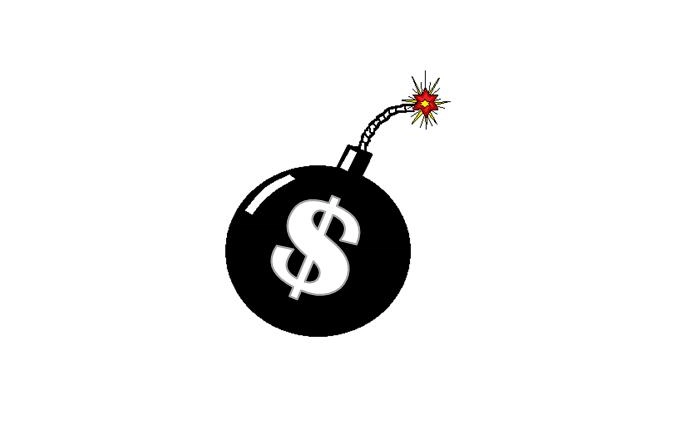Since 1980, when the national debt was $907 billion and just 31.7 percent of the Gross Domestic Product (GDP), the debt has grown by an average of 9 percent a year, to its current level of more than $30.7 trillion — 124 percent of GDP — according to the latest data by the U.S. Treasury and the Bureau of Economic Analysis.
The problem is that nominal GDP — that is, before adjusting for inflation — has only grown by a little more than 5.3 percent annually since 1980, such that the debt has been growing much, much faster than the economy ever could, even with inflation.
As a result, if the debt keeps growing at the average, annual 9 percent pace, while the economy continues nominally growing on average at 5.3 percent a year, the national debt will more than triple to $103 trillion by 2036, or a whopping 201 percent debt to GDP ratio.
That would put the U.S. in territory of Japan (236 percent), Venezuela (233 percent) and Sudan (200 percent), the countries with the highest debt to GDP ratios in the world presently. (To be fair, those countries’ debts will likely be even higher come 2036, too.)
In the meantime, talking heads on television and suits in Washington, D.C. comfort themselves — and a disbelieving American public — that the numbers do not matter, or at least, are not as large as you think they are because of the $30.7 trillion, $6.67 trillion is held by the Social Security and Medicare trust funds, or what is known as intergovernmental holdings.
We owe it to ourselves — or so the rationale goes — and so the trust funds’ treasuries shouldn’t be counted against the GDP when tabulating the debt to GDP ratio. By this logic, the publicly held debt at $24.1 trillion today is not 124 percent of GDP, it’s 97 percent of GDP. You know, happy talk.
A recent Congressional Budget Office publication underscores this analysis, stating, “By the end of 2022, federal debt held by the public is projected to equal 98 percent of GDP.” The office carries that estimate forward: “In CBO’s projections, debt as a percentage of GDP begins to rise in 2024, surpasses its historical high in 2031 (when it reaches 107 percent), and continues to climb thereafter, rising to 185 percent of GDP in 2052.”
Now, a lot of that depends on whether the trust remain solvent or not. For example, as of now, the Social Security trustees project that the Old-Age & Survivors Insurance Trust Fund will be depleted of its treasuries by 2034. And Medicare’s Hospital Insurance trust fund will run out of money in 2028.
When the trust funds go negative, that will mean instead of cashing in treasuries in order to pay out Social Security and Medicare benefits, the money will simply be taken from the Treasury’s general fund, thereby initiating treasuries auctions and adding that money to the publicly held debt in the end anyway.
For that reason alone, Americans for Limited Government has counted the intergovernmental holdings towards the debt to GDP ratio for more than a decade. We believe total debt is what ultimately matters, under the assumption that Congress will likely not vote to decrease Social Security and Medicare benefits even when — or especially when — the trust funds run out of treasuries.
Anyone realistically considering the alternative scenario, that Congress and a sitting president would actually repudiate and cut promised entitlement benefits, should look no further than Dan Rostenkowski being chased by little old ladies from a townhall meeting after proposing increasing taxes to pay for catastrophic health coverage under Medicare in 1989.
Such a plan might not be politically sustainable, and so the more likely outcome is Congress will simply allow benefits to continue to be paid out from the general fund.
In 2021 alone, entitlement or so-called mandatory spending — that is, spending that occurs because outlays are mandated by law rather than being voted upon annually by Congress via appropriations like Social Security, Medicare, Medicaid, unemployment, interest on the debt, etc. — accounted for $5.1 trillion out of $6.8 trillion of spending, according to the White House Office of Management and Budget. That’s more than 75 percent of federal spending, a large jump from its usual levels of about two-thirds of spending or so.
Fortunately, with Covid spending coming to an end, so too are the benefits that were handed out during the Covid recession, including the one-time checks to families. Now, OMB projects mandatory spending will decrease to $4.1 trillion this year. We’ll see how that holds up after the massive green subsidies and other tax expenditures in President Joe Biden’s budget reconciliation bill that will spend $300 billion over 10 years.
Even before Covid in 2020 — where the government borrowed and printed more than $6 trillion to combat the pandemic and keep the economy afloat amid the lockdowns — in 2019, this particular metric of when the debt might hit $100 trillion was already at 2037. Back then the average annual growth rate of the debt was about 8 percent.
The reason the debt keeps exploding like this is primarily due to recessions, especially since the inflation of the 1970s, when simultaneously, revenues slow down because of the economic contraction and the federal government counter cyclically spends more money. Double digit increases the growth rate of the debt occurred in the mid-1970s, the first half of the 1980s, the early 1990s, during the Great Recession of 2008-2009, and during the Covid recession of 2020 and in 2021.
In other words, even though the debt does not growth at 8 or 9 percent every year, the ALG analysis anticipates recessions will ultimately occur on a cyclical basis, even if government budget offices do not. And when they’re particularly severe, and as soon as the unemployment rate starts rising, even as mandatory spending starts picking up again all by itself, you can bet that Congress will be looking for yet another stimulus as surely as sun rises in the east and sets in the west every day.
What it all leads to is anyone’s guess. As the issuer of the world’s reserve currency, the U.S. dollar, U.S. dollar denominated assets like treasuries are in high demand, particularly in recessions when equities sink, which usually keeps interest rates low. Even today, because of high demand for treasuries, the 10-year treasuries interest rate sits at a three-year high of about 3 percent, well below the 8.5 percent consumer inflation rate.
If we have a shallow recession now, inflation might take off again real quick, running the risk of the economy rapidly overheating again.
But there are other intervening factors. Ultimately, much will depend on the verdict the American people render in November. If Democrats can break the midterm jinx, expect a lot more spending and debt. Or if Republicans, say, take back the House in November, and there is mixed government, expect spending to be more subdued because the parties could not agree on the nation’s spending priorities, similar to how budget sequestration tamed discretionary spending in the Obama years after Republicans retook the House in 2010.
Either way, once recessions are factored in, even temporary bouts of fiscal austerity appear unlikely to turn back the overwhelming tide of debt that’s headed our way as the rest of the Baby Boomers retire, a sea of red ink as far the eye can see.
In fact, the only solution ever devised by governments (besides raising taxes to obscene levels) is to tacitly default on those obligations is inflation, thereby reducing the cost of the past obligations, the so-called hidden tax. So, expect more inflation, I’d say. Either way, you’ll pay for it.
Robert Romano is the Vice President of Public Policy at Americans for Limited Government Foundation.








